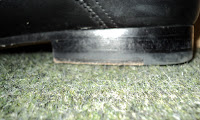One of my other favourite stalls my friend, Jess Hogarth's. http://www.jessicahogarth.com/blog/. She had some screen prints for sale which I really liked, just a bit out of my price range - I got a mug instead (much less damage to my student loan that way). Jess is the artist I used for my welcome week project, and she just so happens to be from my favourite place, Robin Hood's Bay. Her work was really popular. I'd like to sell stuff at the Marketplace in future, it was nice and Christmassy and the work was great, too!
Tuesday, 6 December 2011
Designers Marketplace, Middlesbrough Sat 3rd Dec.
My flat mate Emma and I went to Middlesbrough town hall on Saturday to catch the Christmas Designers Marketplace. It was great! I got to catch up with my friend Jess Hogarth, who was selling there, and met some other amazing artists and designers and got some great advice from them. There was some really nice stuff there, including these ink drawings by Luke Dixon; http://dukelixon.co.uk/. He creates beautiful drawings, wood-cuts and coloured work using inks.
Sunday, 4 December 2011
Photographing Shoes
I tried to focus on the unseen areas of shoes in my photography, by looking at the inside of tatty cowboy boots or and the grubby soles where the pattern has been worn away. These are the most important yet most overlooked parts of shoes in everyday life.
Shoes, shoes, shoes...
Since we've been delving into the fascinating world of shoes these past two weeks (I'm not even being sarcastic), one area which has really grabbed my attention is shoes of the 1920's. Not particularly the style of the shoes being made, but the drastic change in style after the First World War. During the war, women were employed to do all manner of jobs - such as driving trucks, working on the farms. Since the early 1900's were still a mainly patriarchal society, women's fashion before the war had consisted of floor length, heavy dresses. But these were impractical in the war when it was all hands on deck, so women's clothes gradually became shorter, first ankle height, then mid-calf, then knee length frocks. This was to create more freedom to move for the women working to aid the war effort.
This coincided also with the rise of feminism in the early 20th century, so women were demanding more rights and equal treatment. One thing this aided was the woman's decision as to what she wore. Chanel was designing masculine clothing from jersey, a material previously only used to make men's undergarments. The attitude after the war was optimistic, and women had gained a lot more independence during the last decade.
Before then, feet were regarded as ugly and something to be hidden, and since the fashion was floor length dresses this was never an issue. However, when hem lines became higher, feet were permanently visible; and so feet, and shoes especially, became a fashionable accessory to an outfit. This is also around the time Salvatore Ferragamo began to create beautiful hand-made shoes in his studio in Italy.
What I found so intriguing is how the attitudes to feet changed so swiftly. Conversely, in Arab culture it is still to this day a great insult to show ones soles, and shoes are to be removed before entering any religious building. The Japanese still remove their shoes when indoors.
Even after two weeks, I can see that I've only scratched the surface of the history of the shoe. Who'd o' thought...
This coincided also with the rise of feminism in the early 20th century, so women were demanding more rights and equal treatment. One thing this aided was the woman's decision as to what she wore. Chanel was designing masculine clothing from jersey, a material previously only used to make men's undergarments. The attitude after the war was optimistic, and women had gained a lot more independence during the last decade.
Before then, feet were regarded as ugly and something to be hidden, and since the fashion was floor length dresses this was never an issue. However, when hem lines became higher, feet were permanently visible; and so feet, and shoes especially, became a fashionable accessory to an outfit. This is also around the time Salvatore Ferragamo began to create beautiful hand-made shoes in his studio in Italy.
What I found so intriguing is how the attitudes to feet changed so swiftly. Conversely, in Arab culture it is still to this day a great insult to show ones soles, and shoes are to be removed before entering any religious building. The Japanese still remove their shoes when indoors.
Even after two weeks, I can see that I've only scratched the surface of the history of the shoe. Who'd o' thought...
Subscribe to:
Comments (Atom)





























